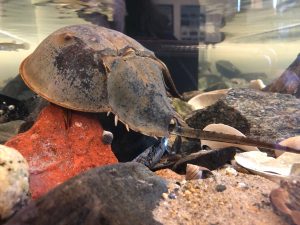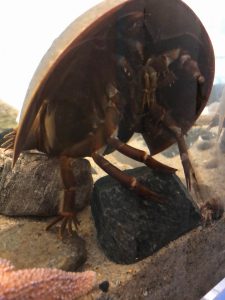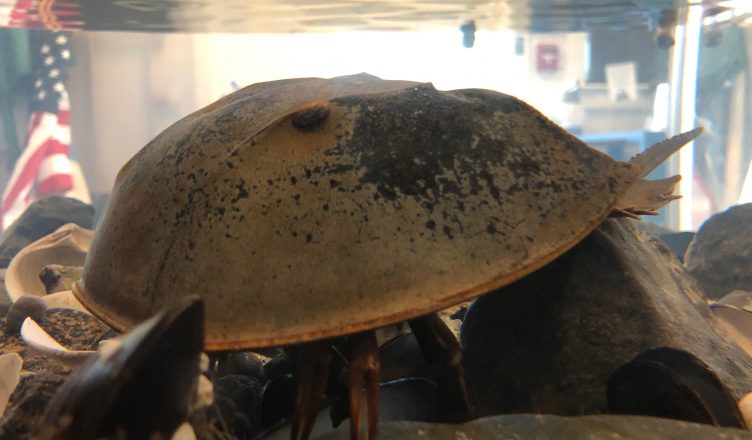This is part of our series about different animals and events at our Blue Ocean Discovery Center. This month we will discuss a favorite Discovery Center inhabitant: the horseshoe crab.
Visitors to the Discovery Center often tell us that they used to find horseshoe crabs in the local harbors and marshes but haven’t seen many in recent years. This is definitely true. Our horseshoe crabs were found in Great Bay and the population there is making a comeback. Perhaps in the future we will see lots more of them in the Hampton/Seabrook estuary.
 Living Fossils
Living Fossils
Horseshoe crabs are often described as living fossils because of their similarity to the trilobite, an extinct marine animal. Horseshoe crab fossils have been found that lived 450 million years ago, 250 million years before the dinosaurs, and they look very much like today’s animals.
The next time you visit the Discovery Center be sure to check out our two male horseshoe crabs. You should be able to identify the three main body parts: the large head or prosoma, the hinged abdomen or opisthosoma, and the spine like tail or telson.
Not a True Crab
The horseshoe crab is not a true crab. True crabs have five pairs of legs, antennae, and jaws. As explained last month, a crab’s abdomen (tail) is tucked under the body and opens for mating and egg carrying. A horseshoe crab has seven pairs of legs, no antennae and no jaws. The horseshoe crab’s mouth is surrounded by the legs and it chews with its “shoulders”. Its long, spike-like tail or telson is often mistaken for a stingray’s tail but it is harmless unless stepped upon. The horseshoe crab is probably called a crab because it has a hard shell and walks with its crab-like appendages. The shell is shaped like a horse’s foot, giving it the name horseshoe.
 A Horseshoe Crab has 10 Eyes!
A Horseshoe Crab has 10 Eyes!
Another big difference between the true crab and the horseshoe crab is the eyes. A true crab has two compound eyes on stalks and it can move them in many directions. The horseshoe crab has ten eyes, but not all of them work during the animal’s entire life span and only four can see images. Two simple lateral eyes are located near the two obvious compound eyes on the shell. The simple eyes are all a horseshoe crab uses to see during the first two or three years of its life. The simple eyes degenerate when the compound eyes develop at age two or three. The compound eyes have many light receptors and are similar to the eyes of other arthropods like insects. These eyes are especially good for seeing after dark, which is when horseshoe crabs need to locate mates. The horseshoe crab also has six eyes that are light sensitive and allow it to tell day from night. These are located on the telson, on the top side of the shell, and on the first pair of legs.
Horseshoe Crabs and Humans
Humans have found horseshoe crabs to be very useful animals. Native Americans ate them, used them for fertilizer, used their shells to bail out their canoes and used the telson for spear tips. Horseshoe crabs were used as fertilizer until the 1950’s and they are still used for bait. Horseshoe crabs also have many medical uses including eye research, the development of surgical sutures, and the detection of bacterial contamination in drugs.
We hope you will visit the Discovery Center and see our horseshoe crabs. We are open every day from mid-June until September, and by appointment.
Learn More:
- A Whale of a Summer at the Blue Ocean Discovery Center
- Creature Feature: Hermit Crab
- Our Adopted Lobster
- More About the Blue Ocean Discovery Center





